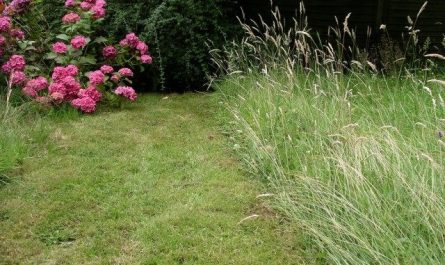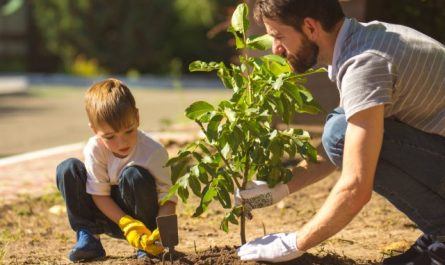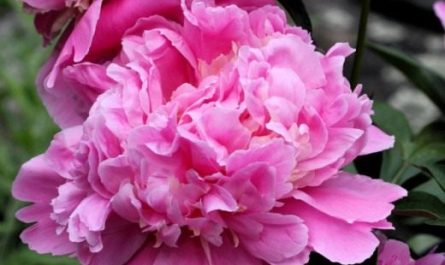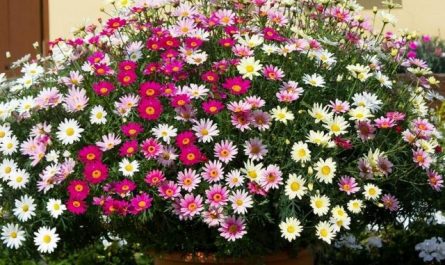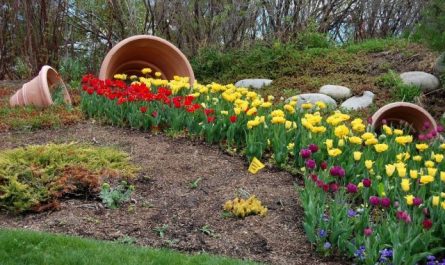Gladioli have a long vegetation period, during which they consume nutrients from various natural compounds and fertilizers from the environment through their roots and partly through their leaves. Like all other plants, they need nitrogen (N), phosphorus (P), potassium (K) in large quantities, and calcium (Ca), magnesium (Mg), iron (Fe), sulfur (S) and other elements in slightly smaller quantities. Nutrients consumed in large quantities are called basic or macronutrients, while those consumed in smaller quantities are called micronutrients. The latter also include boron (B), manganese (Mn), copper (Cu), zinc (Zn), molybdenum (Mo) and others.
Just 65 years ago, it was believed that about ten nutrients that make up the bulk of a plant, such as carbon, oxygen, hydrogen, nitrogen, phosphorus, potassium, calcium, magnesium, iron and sulfur, were sufficient for normal plant growth. It has recently become clear that the list of nutrients needed by plants is much wider.

As a rule, the soil contains enough calcium, sulfur, iron and magnesium compounds for the cultivation of gladioli. Basically, these ornamental plants need nitrogen, phosphorus and potassium, sometimes calcium and magnesium. When growing gladioli in garden plots, a gardener can limit himself to using fertilizers containing three main nutrients – nitrogen, phosphorus and potassium. However, if you want to have inflorescences that stand out for their beauty and power, you need to use fertilizers that contain many other nutrients.
In any case, it is impossible to feed plants without taking into account the content of nutrients in the soil. Therefore, every gardener should submit a soil sample from his plot for analysis once a year, or at most once every three years. Having received data on the content of the main nutrients in the soil on his plot, the gardener develops a system of feeding gladioli for his case, and this requires knowledge of the peculiarities of the consumption of nutrients by plants.

Nutritional Features of Gladiolus
Gladioli are most demanding of nitrogen and potassium. They need comparatively less phosphorus. Therefore, the ratio of the main nutrients (N:P:K) for their normal growth should be 1:0,6:1,8. This ratio refers to the total consumption. At different stages of development, the assimilation of individual nutrients by plants changes. For example, at the beginning of the vegetation of gladioli, nitrogen is needed one and a half times more than potassium, and five to ten times more than phosphorus.
Nitrogen is better consumed by gladiolus plants in the presence of phosphorus and potassium compounds. The greatest consumption of this element by plants is observed during the period of development of one to four gladiolus leaves. Excess nitrogen leads to delayed flowering and deterioration of the quality of the upper flowers, curvature of the peduncle and decreased resistance of the plant to diseases. At the same time, powerful growth of the stem and leaves is noted, in which case the plant is said to be “fattening”.
With a lack of nitrogen, the growth of gladioli is delayed, flowering is weakened. The latter is expressed, in particular, in a decrease in the number of flowers in the inflorescence. In addition, the color of the leaves is light green.
In cases where only nitrogen fertilizers are added to the fertilisers at the initial stage of plant development, growth does not subside for a long time. This can lead to poor ripening of gladiolus corms. In order for the growth processes not to continue after flowering, but to gradually subside, it is better to fertilise with nitrogen fertilizers together with phosphorus and potassium fertilizers at such times. With abundant nitrogen nutrition, the size of gladiolus corms can exceed the usual, but their internal structure is worse, they age faster, and plants from them grow poorly.
If you grow adult gladioli corms (two years and older), then in the initial period of development there is no need to feed them with phosphorus fertilizers – the planting material and soil provide all the plant’s needs. Gladioli are very demanding of potassium nutrition, so plants from adult corms are fed with nitrogen and potassium in the initial period of development. For baby corms, which do not have such reserves of nutrients, it is better to give a complete fertilizer, that is, containing nitrogen, phosphorus and potassium.
Potassium should be included in the nutrition of gladioli throughout the growing season, as it is involved in compounds that ensure the movement of plant juices. This element makes the plant more resilient in bad weather and diseases. If there is not enough potassium, then the old leaves of gladioli give it to the young ones, and they themselves dry up and die. First, the edges of the leaves dry up. The flower stalk grows weakly, and is shortened.
If during the period of formation of three or four leaves, when the gladioli peduncle is formed, a sufficient amount of potassium is not given as a top dressing, the number of buds in the peduncle decreases. However, the greatest consumption of potassium, as well as nitrogen and phosphorus, in gladioli is observed during budding. Moreover, if for phosphorus this increase is small, then the increase in the consumption of potassium and nitrogen occurs very sharply with a subsequent not so sharp decline.
A lack of potassium after gladioli bloom affects the quality of the corms, which are poorly stored and produce poorly developing plants the following year.
The need for phosphorus hardly changes during the growing season, only increasing slightly during budding and flowering. A lack of phosphorus delays growth and flowering. After flowering, combined feeding of gladiolus plants with phosphorus and potassium fertilizers promotes better outflow of nutrients from the leaves into the new corm.
Providing gladioli with nutrients in the required quantities is possible only by supplementing soil compounds with mineral and organic fertilizers.
On the packaging of mineral fertilizers purchased in specialized stores, the amount of nutrients included in them is indicated as a percentage, usually by active substance: nitrogen – N, phosphorus oxide – P205, potassium oxide — K20.

What mineral fertilizers can be used for gladioli
In agriculture, many different fertilizers are used. We will consider only those that an amateur gardener can buy in a store (table 1).
Table 1: Types of mineral fertilizers containing one nutrient (listed by active ingredient)
| Nitrogen | Phosphoric | Potash |
| Urea (N – 46%) | Double superphosphate (P205 — 45%) | Potassium sulfate (potassium sulfate, K20 — 46-52%) |
| Ammonium sulfate (N – 21%) | Superphosphate (P205 — 14-20%) | Potassium chloride (potassium chloride, K20 — 57- 60%) |
| Sodium nitrate (N – 16%) | Bone meal (P205 — 15-30%) | Potassium carbonate (potassium carbonate, potash, K20 — 57-64) |
In addition to mineral fertilizers containing one nutrient, there are complex and complete fertilizers, which include two or three main nutritional elements. The following fertilizers are usually used for gladioli: complex – potassium nitrate (N – 13%, K20 – 46%), potassium magnesium (K20 — 28-30%, Mg — 8-10%); full — nitrophoska (N — 11%, P205 — 10%, K20 – 11%), nitroammophoska (N – 13-17%, P205 — 17-19%, K20 — 17-19%).
There are other types of fertilizers that can be used when growing gladioli after preliminary testing. The industry also produces liquid complex fertilizers that can be given as top dressing.
The most important micronutrients for gladiolus culture include ammonium molybdate, copper sulfate (copper sulfate), zinc sulfate, manganese sulfate, cobalt nitrate, boric acid, and sometimes potassium permanganate, which also serves as a potassium fertilizer, but is more often used as a disinfectant.
Microfertilizers must be handled with great care, as their overdose can lead to the death of plants. The main rule when applying them is not to prepare feeding solutions of any compound with a concentration of more than 2 g per 10 l of water.

What types of organic fertilizers are there?
Among organic fertilizers, the most accessible to amateur gardeners are peat, compost, rotted manure and chicken manure. Fresh manure cannot be used for gladioli, as it is a source of pathogens of fungal and bacterial diseases. Organic fertilizers contain all the main nutritional elements (tables 2 and 3).
Table 2: Content of essential nutrients (in percent dry matter) in organic fertilizers
| Type of manure (droppings) | N | Р205 | K2O |
| Sheep | 0,83 | 0,23 | 0,67 |
| Horse | 0,58 | 0,28 | 0,55 |
| Bovine | 0,34 | 0,16 | 0,40 |
| Pork | 0,45 | 0,19 | 0,60 |
| Bird droppings | 0,6-1,6 | 0,5 | 1,5 0,6-0,9 |
Table 3: Content of essential nutrients (in percent dry matter) in peat
| Peat type | N | P2O5 | К20 |
| Highland / Lowland | 0,8-1,4 / 1,5-3,4 | 0,05-0,14 / 0,25-0,60 | 0,03-0,10 / 0,10-0,20 |

How and when to apply fertilizers?
Fertilizers for gladioli are given at different times in different ways. There are methods of pre-planting fertilization, pre-planting and post-planting fertilization. The latter is divided into root and non-root feeding.
Organic, phosphorus and potassium fertilizers are added during soil digging in autumn. Fertilizer doses depend on the soil and conditions of gladioli cultivation. For example, in autumn, one or two buckets of organic fertilizers and 1-30 g of superphosphate and potassium sulfate can be added per 40 m. In spring, no later than two weeks before planting, 1-20 g of urea are added per 30 m. Pre-planting fertilizer is incorporated into the soil during digging in both spring and autumn; pre-planting fertilizer is added simultaneously with planting into holes and furrows 3-4 cm below the level of corms.
Root and foliar feeding of gladioli is necessary to enhance the nutrition of plants with certain elements in certain periods. Feeding doses are determined based on the characteristics of the site, soil analysis, and the appearance of gladioli. Factors such as soil composition, its acidity, the presence of nutrients necessary for plants, the microclimate and location of the site, and the height of groundwater are taken into account. Pre-planting and near-planting application of fertilizers is considered auxiliary. Root feeding of gladioli is strictly timed to a certain stage of plant development. Liquid feeding is preferable, since nutrients immediately enter the area of the root system.
The amount of fertilizers applied during the season in top dressing is calculated not only based on the soil analysis data, but also based on the density of gladioli planting, doses of pre-planting and planting fertilizers. Fertilizers are usually dissolved in 10 liters of water and used per 1 m .
It is difficult to make sufficiently accurate calculations, since at the depth of gladioli roots (0,2-0,5 m) the composition of nutrients constantly changes due to rain or, conversely, drying out, as well as their binding with soil compounds. Therefore, when developing their own feeding system, the gardener uses the data known from the literature, adjusting it based on personal observations and experience over several years. As such an initial starting point, one can take the feeding system developed by V. N. Bylov and N. I. Raikov (Table 4).
Table 4: Fertilizer doses for feeding gladioli during the growing season, in grams of nutrient per 1 m²
| Plant development stage | N | Р | K | are | Mg |
| Two or three leaves are developed | 30 | 30 | 30 | 10 | 20 |
| “four to five sheets | 15 | 30 | 60 | 10 | 20 |
| “seven to eight sheets | 15 | 60 | 60 | 10 | 20 |
| Period of budding | — | 30 | 60 | — | — |
| 15 days after cutting the flower stalks | — | — | 60 | — | — |
Experienced gardeners divide the doses of fertilizers indicated in the table in half and apply fertilizers more often in smaller doses. This takes more time, but allows the soil to maintain the required nutrient content more evenly. Thus, ten fertilizers are applied over three summer months.
During the growing season, not only macro- but also microelement feeding is effective. Microelements contribute to the formation of more powerful plants with large flowers. Feeding them is especially important at the stage of three to four leaves, when the gladiolus peduncle is formed. According to the recommendation of A. N. Gromov, 10 g of boric acid and potassium permanganate, 2 g of cobalt nitrate, 0,5 g of copper sulfate, 1 g of zinc sulfate and 1 g of magnesium sulfate are taken per 5 liters of water. It is necessary to remember that an unjustified increase in the doses of microelements causes oppression of plants or even their death.
Thus, when growing gladioli, you have to constantly count the leaves, timing the feeding to a certain number of them. It is easier to do this work if large corms are planted separately from small ones, and small ones – separately from the baby. Experienced gardeners who have collected a large collection of gladioli also separate the plantings of early and late varieties. All this makes the feeding more effective, since the nutrition of the baby and young corms differs from the nutrition of the adult corm – young planting material requires one and a half to two times more intensive nutrition.
Foliar feeding also provides macro- and microelements. They allow you to very quickly intervene in the development of plants. So, with poor development of gladioli leaves and their light green color, foliar feeding with urea is given. During flowering, foliar feeding with phosphorus and potassium fertilizers works well, of course, if you exclude the possibility of the solution getting on the flowers.
Micronutrient feeding of gladioli is very effective. A. N. Gromov recommends micronutrient feeding in the phase of development of two or three leaves, especially if the weather is hot. To speed up flowering during the development of the sixth leaf, he suggests foliar feeding of the following composition: 2 g of boric acid and 1,5-2 g of potassium permanganate, dissolved in 10 liters of water. Baltic flower growers believe that two-three times spraying with micronutrient solutions during the growing season not only increases the number of flowers in gladioli, but also promotes the formation of larger corms. A. Zorgewitz suggests spraying gladioli plants with a solution containing the following micronutrients, in grams per 10 liters of water:
- Boric acid – 1,3
- Copper sulfate – 1,6
- Manganese sulfate – 1
- Zinc sulfate – 0,3
- Cobalt nitrate – 0,1
- Ammonium molybdate – 1
- Potassium permanganate – 1,5

Questions – Answers
Question 1. How to calculate the amount of fertilizer needed to feed gladioli if the required amount of the nutrient is known?
Response. Let’s assume that it is necessary to feed plants with nitrogen, phosphorus or potassium at the rate of 30 g of each element per 1 m . The gardener has the following fertilizers on his farm: nitrogen – urea phosphorus – superphosphate potassium – potassium sulfate. According to Table 1, we find the content of the nutrient element in these fertilizers. For the calculation, we will take the first figure, since it is better to underfeed than to overfeed. Therefore, we assume that 100 g of each fertilizer contains 46 g of nitrogen, 20 g of phosphorus and 52 g of potassium, respectively. Then the amount of fertilizer for feeding in each case 30 g of the active substance can be determined by the formula:
- urea 100 g x 30 g: 46 g – 65 g;
- superphosphate 100 g x 30 g: 20 g – 150 g;
- potassium sulfate 100 g x 30 g: 52 g – 58 g.
It is inconvenient to weigh fertilizers every time. It is better to use some kind of measure. For example, you can use a tablespoon, especially since you will not have to touch the fertilizers with your hands. (Of course, such a spoon cannot be used when cooking.) One tablespoon contains 25-30 g of bulk substance. In our example, counting at the upper limit, for 1 m you need to use two tablespoons of urea, five of superphosphate and two tablespoons of potassium sulfate.
Question 2. Is it possible to feed gladioli with mullein?
Response. Gladiolus plants can be fed with mullein, as it contains all the basic nutrients. However, it is not used in concentrated form, but as an infusion in a ratio of one part mullein to 10-15 parts water. Beginning gardeners are better off using only mineral fertilizers at first. Only after mastering the culture can organic fertilizers be used, remembering that mullein, especially fresh, is a source of pathogens for many plant diseases. Manure extract is most often prepared for feeding. To do this, a bag of coarse fabric with manure is hung in a barrel of water at a rate of one part manure to four to five parts water. Infuse for five to seven days. The finished extract is diluted three to four times and fed, using up to 10 liters of solution per 1 m.
Question 3. How much phosphorus and potassium is contained in potassium phosphate?
ResponsePotassium phosphate, or potassium phosphate, is not a fertilizer, but many gardeners buy this substance in a chemical reagent store and use it on their plots. Mono- and dibasic potassium phosphates are often used. To determine the amount of phosphorus and potassium in them, you need to know the chemical formula of the substance and the atomic weights of the elements included in it. The chemical formula of monobasic potassium phosphate is KH2PO04. The atomic masses of the elements included in it are: K -39, H – 1, P -31, O -16. Consequently, the mass of monobasic potassium phosphate in units of atomic (now molecular) mass will be:
- 39 + 1×2 + 31 + 16×4 = 136.
If we take the amount of this substance in grams, numerically equal to the molecular mass, we can calculate how much potassium (X) it contains, %:
- 136g KN2R04 — 100%
- 39 g K – X %
- X = 39 x 100 : 136 = 29%.
Accordingly, the phosphorus content will be, %:
The formula for dibasic potassium phosphate is K2HPO04.
The sum of its molecular weight
- 39 x 2 + 1 + 31 + 16 x 4 = 174.
We calculate the percentage content of potassium for the amount of dibasic phosphate by weight in grams, numerically equal to its molecular weight, that is, 174 grams:
- (39 x 2) x 100% : 174 = 45%.
We calculate the phosphorus content in a similar way:
When using the listed compounds for fertilization, it is important to remember that monobasic potassium phosphate has an acidic reaction, while dibasic potassium phosphate has an alkaline reaction.
Materials used:
- V. A. Lobaznov – Gladioli



